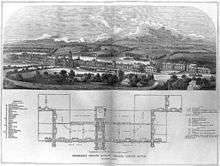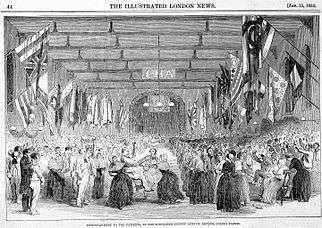Friern Hospital

Friern Hospital (formerly Colney Hatch Lunatic Asylum) was a psychiatric hospital in Colney Hatch in what is now the London Borough of Barnet. The hospital was built as the second Middlesex County Asylum and was in operation from 1851 to 1993.[1]
At the time of construction, the asylum had 1,250 beds and was the largest and most modern asylum in Europe. At its height Colney Hatch was home to 3,500 mental patients and had the longest corridor in Britain (It would take a visitor more than two hours to walk the wards).[2] For much of the 20th century, its name was synonymous among Londoners with any mental institution.
The asylum was situated on Friern Barnet Road and is shown on the Ordnance Survey map of 1876–1881, which also marks Colney Hatch Park in the area centred on Springfield Road in New Southgate, in the London Borough of Enfield, although the hospital was located further west in what is now generally called Friern Barnet, in the London Borough of Barnet. It was close to the Great Northern Railway and had its own railway station.[2]
Design and construction

Originally plans were made for the new asylum to be built near to the existing 1st Middlesex County Asylum at Hanwell on ground on the other side of the Grand Union Canal and a large piece of land was purchased for this purpose. However, these plans were never realised and the present site was selected instead, perhaps due to the number of other asylums already in the area.
The architect was Samuel Daukes, whose Italianate corridor-plan design was based on the advice of John Conolly, the superintendent of the 1st Middlesex Asylum. The foundation stone was laid by the Prince Consort in 1849, and the building was completed in November 1850. The cost of building had been estimated at £150,000, but the final cost actually proved to be £300,000, making it the most expensive asylum ever built, at £240 per bed. The estate had its own water supply, a chapel, cemetery and a 75-acre farm estate.[3] It also had a gasworks, brewery, and an aviary where canaries were bred.[4]
Local authority

The asylum was opened on 17 July 1851 by Prince Albert[4] and was officially referred to as the Second Middlesex County Asylum, with William Charles Hood (1824–1870) being its first medical superintendent.[5]
In 1857 extensions were built to bring the total number of inmates to 2,000. By this time, serious defects of construction had become apparent: in one ward the walls and rafters separated and the arched ceiling gave way while in another ward part of the ceiling collapsed. It was found that the roof was insufficient and that the foundations were insecure, necesscitating reinforcement works in 1858.
Further extensions were added from 1875 to 1879, and by 1880 conditions for inmates had become very poor. In 1896, a temporary building of wood and corrugated iron was erected to house 320 chronic and infirm female patients in five dormitories, despite warnings from the Commissioners in Lunacy that this would pose a serious fire risk.[3]
In 1889 control of the asylum was transferred to the newly formed London County Council.[2]
On 27 January 1903, the temporary building erected in 1896 was destroyed by a fire which claimed 52 lives.[2] In its place, between 1908 and 1913 seven new permanent brick villas were built: four for the survivors of the fire, one for subnormal boys with epilepsy or disturbed behaviour and two for patients with tuberculosis or dysentery. In 1912 a disused carpenters' shop and stores by the railway siding were converted into additional accommodation for male patients and further extensions were made to staff accommodation in 1927, by which time staff included 9 full-time doctors, 494 nurses and 171 probationers.[3]
In 1930, following the Mental Treatment Act, the asylum was renamed the Colney Hatch Mental Hospital. In 1937 a female nurses' home was built, the resulting transfer of staff allowing the accommodation of 89 female patients in the old nurses' block. In the same year the hospital was once again renamed, this time as Friern Mental Hospital.[3]
Second World War
During the Second World War twelve wards were requisitioned for use by the Emergency Medical Service (EMS) to be run by St Bartholomew's Hospital. The wards were used to accommodate 900 civilian war casualties and the displaced mental patients were redistributed around other wards and to Bexley Hospital in Kent. In 1941 five villas were destroyed by bombs and thirty-six patients and four nurses were killed. By 1944 the hospital had 2,557 beds for mental patients and 746 EMS beds.[3]
National Health Service
In 1948 the hospital became part of the newly formed National Health Service. In 1958 a new 145-bed admission unit, Halliwick Hospital, was built to the northwest of the main building.[3] The 1959 Mental Health Act required that the word 'mental' be omitted from hospital names, and the hospital became known as Friern Hospital.[2]
In 1963 a cafe was opened for patients and visitors. Patients were able to earn up to 16/- (80p) 'pocket money' per week to spend in the cafe and hospital shop by working on the wards, kitchen and laundry. Male patients could also be paid in tobacco for their work.[3]
By 1965, Friern Hospital housed 899 male and 1,037 female patients and employed 116 male and 113 female nurses plus 43 male and 33 female student nurses. In July 1965 Lord Strabolgi, speaking in the House of Lords criticised the hospital for the number of patients who were there merely because they were old. A Committee of Enquiry held in 1966 found that the hospital accommodated 708 patients over the age of 60 years, of whom 253 (36%) were considered by clinicians not in need of psychiatric care. The report highlighted the lack of alternative accommodation for the elderly and the lack of social workers which in effect meant that there was nowhere else for elderly disturbed patients to be housed.[3]
It was one of the hospitals investigated in 1967 as a result of the publication of Barbara Robb's book "Sans Everything". One of the allegations concerned lack of entertainment for middle-aged schizophrenic patients and of occupation for many of the elderly. The investigators concluded that "They may appear to be bored and dejected: in fact they are often incapable of animation." The Committee rejected entirely the allegation that everything in Friern was arranged for the benefit of the staff, including the suggestion that "the Physician Superintendent was seldom in the hospital for more than one or two hours a day". The latter gave evidence, which was accepted, that he attended the hospital daily from 9 am to 5.30 pm except on Wednesday afternoons.[6]
Radio Friern
The hospital's internal broadcasting service started in 1971 after funds were raised by Minchenden Grammar School. Initially broadcasting to six wards from a studio in the patients' social club, the station expanded to cover most wards and departments within the hospital. Radio Friern moved to a new studio in premises originally occupied by the hospital dentist in 1975 increasing its broadcasting hours by the early 1980s to include programmes airing six days a week. The station continued to broadcast until the hospital's closure in 1993. Reference to the radio service in Barbara Taylor's book The Last Asylum is incorrect. Radio Friern was staffed by volunteers with day jobs away from the hospital, no patients were involved. Programmes would typically start at 5pm weeknights as the first volunteers finished work. The weekend schedule started at 9am. Staffed by no more than 25 people,Radio Friern was Friern Hospital's 'Big Little Station'.
Decline and closure
In 1973 the number of patients had been reduced to 1,500, and by 1979 the hospital had only 1,023 beds. In 1989 it was decided that the hospital should close and its patients reintegrated into the community where possible. Closure came in 1993, and the building and grounds were sold to Comer Homes in 1995,.[7] The building was converted into luxury flats called Princess Park Manor.[3]
Residents of the development have included members of the boy band One Direction, pop stars and footballers.[7]
Notable residents
- John Duffy, British serial killer and rapist.
- Aaron Kosminski, a Jack the Ripper suspect.
- Dorothy Lawrence, a woman who dressed as a man to fight on the front lines of World War I.
- Maria Teresa Ferrari de Miramar, one of Aleister Crowley's wives.
- Jenny Diski, an English writer, briefly stayed at the hospital.[8]
In literature
The asylum is referenced (as a byword for madness) in chapter 8 of the children's novel The Magician's Nephew, part of the Chronicles of Narnia by C.S Lewis: when Jadis proclaims herself as an Empress and demands that residents of London bow to her, they jeeringly respond by saying in Cockney dialect, "Three cheers for the Hempress of Colney 'atch!".[9]
Will Self's 2012 novel Umbrella is largely set in the hospital.[10]
Historian Barbara Taylor’s book The Last Asylum: A Memoir Of Madness In Our Times is a memoir describing an eight-month period when she lived in the asylum, following a nervous breakdown.[11]
See also
References
- ↑ "Middlesex County Asylum Colney Hatch". www.thetimechamber.co.uk. Retrieved 2014-01-30.
- 1 2 3 4 5 Dumayne, Alan (1998). Southgate. Sutton Publishing Limited. p. 118. ISBN 0-7509-2000-9.
- 1 2 3 4 5 6 7 8 9 "Lost Hospitals of London: Friern". Retrieved 2012-04-18.
- 1 2 "Daily Life in the Asylum | Historic England". English-heritage.org.uk. 1911-06-22. Retrieved 2015-08-14.
- ↑ "Index of Lunatic Asylums and Mental Hospitals". www.mdx.ac.uk. Retrieved 2008-12-09. Archived May 27, 2009, at the Wayback Machine.
- ↑ "Part 3 of Findings and Recommendations Following Enquiries into Allegations Concerning the Care of Elderly Patients in Certain Hospitals". Cmnd. 3687. HMSO. July 1968. Retrieved 13 May 2015.
- 1 2 Bloomfield, Ruth (2012-10-04). "Princess Park Manor: From Asylum to Posh Retreat for One Direction - WSJ". Online.wsj.com. Retrieved 2015-08-14.
- ↑ The London Review of Books, Vol. 36, No. 3, 6 Februari 2014 www.lrb.co.uk. Retrieved 2014-02-07.
- ↑ Lewis, CS (2005). The Magician's Nephew. (HarperCollins ed.). New York: HarperTrophy. ISBN 978-0064471107.
- ↑ Mark Lawson. "Umbrella by Will Self – review | Books". The Guardian. Retrieved 2015-08-14.
- ↑ "Barbara Taylor's The Last Asylum is a compelling personal history | Metro News". Metro.co.uk. 2014-02-13. Retrieved 2015-08-14.
External links
Coordinates: 51°36′50″N 0°08′54″W / 51.61402°N 0.14839°W